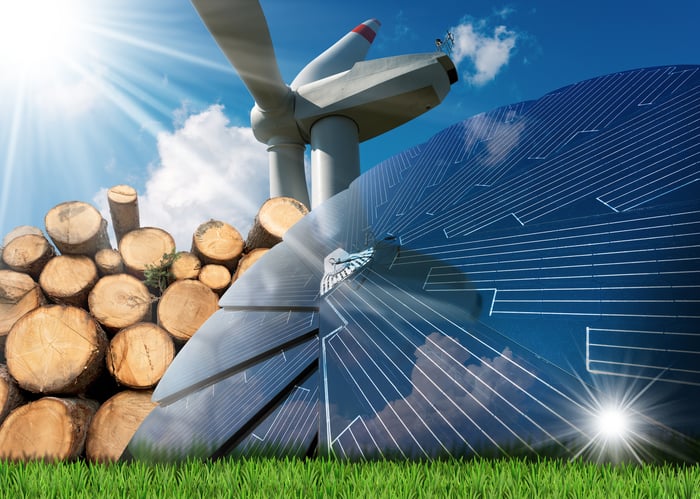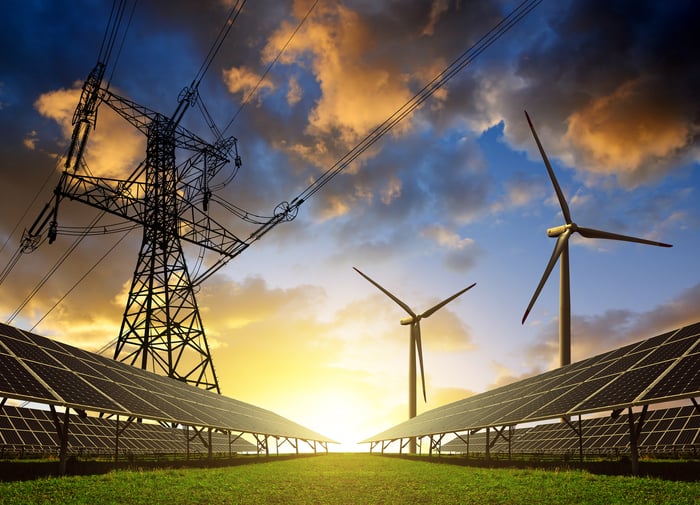Alternative energy covers a wide range of sources, with almost anything that's not a fossil fuel falling under the banner. That includes common renewable energy sources such as wind, solar, hydro, and biomass, as well as clean energy options such as nuclear, in addition to emerging alternatives such as algae fuel, wave power, and hydrogen. The overarching theme is that these energy sources produce fewer carbon dioxide emissions, which makes them a better alternative than fossil fuels, given growing climate change concerns.
Those environmental concerns, when combined with falling costs for renewable sources, has fueled breathtaking growth in alternative energy over the past few years. According to the International Energy Agency (IEA), two-thirds of all new power capacity added around the globe in 2016 came from renewables, with solar power, for example, growing by 50%. That brisk growth rate appears poised to continue, with the IEA anticipating that global renewable electricity capacity will increase by 43% through 2022. That rapidly expanding market for renewables could fuel market-beating returns for investors in alternative energy stocks in the coming years. Here's are five promising ones to consider buying as the renewable energy market heats up.

Image source: Getty Images.
A high-yield from hydropower
Brookfield Renewable Partners (BEP 1.40%) is one of the largest independent renewable power operators in the world. Overall, it controls 261 generating facilities in North and South America as well as Europe, with hydroelectric making up about 85% of its portfolio. Aside from the clean power those plants generate, the other important thing worth noting about Brookfield Renewable is that it sells this electricity under long-term contracts, which provides it with a steady stream of cash flow. The company distributes about 70% of that money to investors in a payout that currently yields 5.5% and retains the rest to build additional hydro and wind facilities. Those new plants, when combined with the company's upside to higher power prices, should enable Brookfield Renewable to organically grow cash flow by 6% to 11% annually over the long-term. That rising cash flow stream would then allow the company to increase its already generous distribution to investors by 5% to 9% per year, making it an excellent option for income-seekers.
The wind is at its back
Pattern Energy Group (PEGI) currently operates 20 wind farms in the U.S., Canada, and Chile. Like Brookfield Renewable, the company has also secured long-term contracts for the power generated from these facilities, which provides Pattern Energy with a predictable cash flow stream. The company sends the bulk of that cash flow back to investors via a 7.6%-yielding dividend.
Pattern Energy has a slightly different fuel for growth, with it primarily acquiring wind farms developed externally. The company does have the right-of-first-refusal on a large pipeline of projects, which provide it with excellent visibility into future growth. Those anticipated additions should continue increasing cash flow, enabling Pattern Energy to keep growing its generous dividend.

Image source: Getty Images.
A bright future
First Solar (FSLR 0.71%) is a leading global solar panel maker, with its focus on building larger panels for commercial-scale projects. The company recently laid out its growth plans through 2020, driven by its newly released Series 6 panel, which is larger and more efficient than its Series 4 module. First Solar is currently making them as fast as it can and has already booked 6.7 GW of panel shipments this year. That's a stunning number for a company that only has the capacity to build 2 GW of solar panels next year. It also plans to double its production rate by the end of 2019 by adding more manufacturing capacity, which should rise to 5.4 GW when additional plants come online in 2020. With several years of growth already locked in, this solar stock's profits should heat up in the coming years.
Turing trash into cash
Covanta Holdings (CVA) is the world leader in energy-from-waste by burning garbage to produce electricity. In fact, this source of power is the only one that reduces greenhouse gas emissions because it takes waste that would have continued producing emissions in a landfill and converts it into lower emission energy. Covanta's business model is also unique because it gets paid a fee to collect its fuel source and then makes more money by selling the electricity its facilities generate to utilities under long-term contracts. This lucrative arrangement enables Covanta to produce lots of cash, which it uses to pay a 6%-yielding dividend. Meanwhile, it has ample growth opportunities, including recently securing a joint venture in Europe that positions the company to grow free cash flow by a 10% annual growth rate over the long-term.

Image source: Getty Images.
Proving that money does grow on trees
Enviva Partners (EVA) is the world's largest supplier of utility-grade wood pellets, which it sells under long-term contracts to utilities in Europe that burn them in place of coal. Those agreements supply Enviva with steady cash flow, which allows it to pay an attractive 8.2% distribution to investors. Meanwhile, it has ample growth potential as it builds and buys additional wood pellet production capacity. In fact, the company's parent already has one new plant under construction that should start producing in 2019, which it could drop down to Enviva, as well as others under evaluation. Those future deals should provide the company with the fuel to continue increasing shareholder distributions.
A lower-risk alternative
While renewable energy is growing briskly, alternative energy stocks haven't generated the returns investors had hoped in recent years because profitability hasn't always followed revenue growth. However, shouldn't be an issue with these stocks because all sell their power, fuel, or panels either through long-term contracts or advanced orders, which gives them a good grasp on future revenue and earnings. That higher level of clarity makes it more likely that these companies can create value for investors, which is what makes them the top options in the sector to consider buying.





